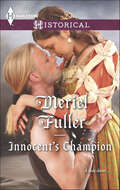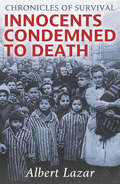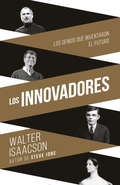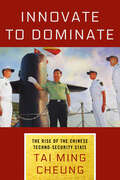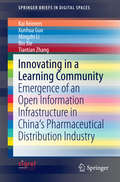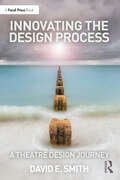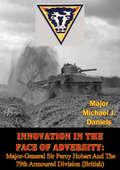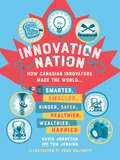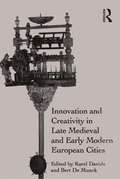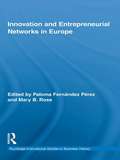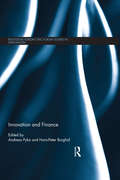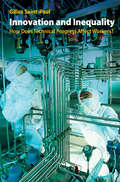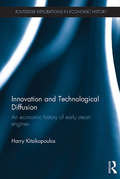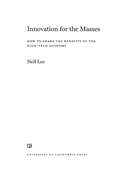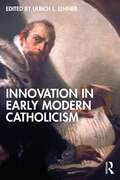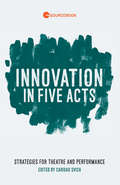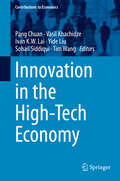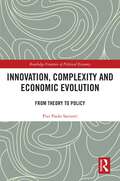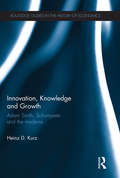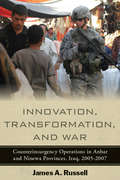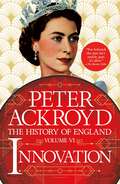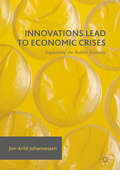- Table View
- List View
Innocent's Champion
by Meriel FullerTo win a knight's protection When Gilan, Comte de Cormeilles, dodges an arrow aimed straight for his head, the last person he expects to be holding the bow is a beautiful, courageous woman... Despite her innocence, Matilda of Lilleshall is no simpering maiden. She'll stop at nothing to protect her land. Believing he'd never again feel anything but guilt after his brother's death, Gilan must now confront the undeniable desire Matilda incites. Can he throw off his past and fight to become the champion she needs? "Fuller brings this tale to life with vivid descriptions." -RT Book Reviews on Captured by the Warrior
Innocents Abroad: American Teachers in the American Century
by Jonathan ZimmermanProtestant missionaries in Latin America. Colonial "civilizers" in the Pacific. Peace Corps Volunteers in Africa. Since the 1890s, thousands of American teachers--mostly young, white, middle-class, and inexperienced--have fanned out across the globe. Innocents Abroad tells the story of what they intended to teach and what lessons they learned. Drawing on extensive archives of the teachers' letters and diaries, as well as more recent accounts, Jonathan Zimmerman argues that until the early twentieth century, the teachers assumed their own superiority; they sought to bring civilization, Protestantism, and soap to their host countries. But by the mid-twentieth century, as teachers borrowed the concept of "culture" from influential anthropologists, they became far more self-questioning about their ethical and social assumptions, their educational theories, and the complexity of their role in a foreign society. Filled with anecdotes and dilemmas--often funny, always vivid--Zimmerman's narrative explores the teachers' shifting attitudes about their country and themselves, in a world that was more unexpected and unsettling than they could have imagined.
Innocents Condemned to Death: Chronicles of Survival
by Albert LazarInnocents Condemned to Death: Chronicles of Survival, first published in 1961, is a brief but moving account of the Jewish Holocaust in Hungary during World War Two. The book portrays life under the Nazi occupation and provides glimpses into a family's experiences—their separations, deportations to labor camps, interrogations, reuniting, emigration to South America—all interwoven with a powerful faith and will to survive. Included are 4 pages of photographs.
Innocents Lost: When Child Soldiers Go To War
by Jimmie BriggsIda, a member of Sri Lanka's Female Tamil Tigers, fought with one of the longest-surviving and successful guerilla movements in the world. She is sixteen. Francois, a fourteen-year-old Rwandan child of mixed ethnicity, was forced by Hutu militiamen to hack to death his sister's Tutsi children.More than 250,000 children have fought in three dozen conflicts around the world, but growing exploitation of children in war is staggering and little known. From the "little bees" of Colombia to the "baby brigades" of Sri Lanka, the subject of child soldiers is changing the face of terrorism. For the last seven years, Jimmie Briggs has been talking to, writing about, and researching the plight of these young combatants. The horrific stories of these children, dramatically told in their own voices, reveal the devastating consequences of this global tragedy.Cogent, passionate, impeccably researched, and compellingly told, Innocents Lost is the fullest, most personal and powerful examination yet of the lives of child soldiers.
Innovadores (Innovators-SP)
by Walter IsaacsonTras su extraordinaria biografía de Steve Jobs, el nuevo libro de Walter Isaacson cuenta la fascinante historia de las personas que inventaron el ordenador e internet; Los innovadores está destinado a convertirse en la historia definitiva de la revolución digital y en una guía indispensable para entender cómo sucede realmente la innovación. ¿Qué talentos y habilidades permitieron a algunos inventores y empresarios convertir sus ideas visionarias en realidades disruptivas? ¿De dónde vinieron esos saltos creativos? ¿Por qué algunos triunfaron y otros fracasaron? En esta magistral saga, Isaacson arranca con Ada Lovelace, la hija de lord Byron, una pionera de la programación informática en la década de 1840. Además, presenta a las extraordinarias personas que crearon la revolución digital que nos rodea, gente como Vannevar Bush, Alan Turing, John von Neumann, J. C. R. Licklider, Doug Engelbart, Robert Noyce, Bill Gates, Steve Wozniak, Steve Jobs, Tim Berners-Lee o Larry Page. Esta es la historia de cómo funcionan sus cerebros y por qué han sido tan inventivos, pero también de cómo su capacidad para colaborar y dominar el ar te del trabajo en equipo les hizo aún más creativos. En una era que busca fomentar la innovación, la creatividad y el trabajo en equipo, Los innovadores es la obra que mejor muestra cómo se producen.
Innovate to Dominate: The Rise of the Chinese Techno-Security State
by Tai Ming CheungIn Innovate to Dominate, Tai Ming Cheung offers insight into why, how, and whether China will overtake the United States to become the world's preeminent technological and security power. This examination of the means and ends of China's quest for techno-security supremacy is required reading for anyone looking for clues as to the long-term direction of the global order. The techno-security domain, Cheung argues, is where national security, innovation, and economic development converge, and it has become the center of power and prosperity in the twenty-first century. China's paramount leader Xi Jinping recognizes that effectively harnessing the complex interactions among security, innovation, and development is essential in enabling China to compete for global dominance. Cheung offers a richly detailed account of how China is building a potent techno-security state. In Innovate to Dominate he takes readers from the strategic vision guiding this transformation to the nuts-and-bolts of policy implementation. The state-led top-down mobilizational model that China is pursuing has been a winning formula so far, but the sternest test is ahead as China begins to compete head-to-head with the United States and aims to surpass its archrival by mid-century if not sooner. Innovate to Dominate is a timely and analytically rigorous examination of the key strategies guiding China's transformation of its capabilities in the national, technological, military, and security spheres and how this is taking place. Cheung authoritatively addresses the burning questions being asked in capitals around the world: Can China become the dominant global techno-security power? And if so, when?
Innovating in a Learning Community
by Kai Reimers Xunhua Guo Mingzhi Li Bin Xie Tiantian ZhangHow do firms jointly develop open information infrastructures? To answer this question, this book draws on the results of a longitudinal research project covering the development of the pharmaceutical distribution industry in China from 2004 to 2012, focusing on the emergence and subsequent evolution of industry-wide information infrastructures. How do firms delimit areas of proprietary innovation in open innovation projects? How do firms coordinate, initiate, negotiate and implement the development of innovative infrastructures? How do processes and practices within firms enable and constrain such collective efforts? - This book provides answers to these questions and draws conclusions regarding the challenges and new capabilities that firms will need in a world in which participation in the building of open information infrastructures becomes a necessary task for commercial organizations.
Innovating the Design Process: A Theatre Design Journey
by David E. SmithInnovating the Design Process: A Theatre Design Journey explores the process of designing for theatre and details how each part of a designer’s own process, no matter what their design specialization, can be innovated and adapted for a more confident journey and for better outcomes. The book observes and deconstructs the processes used by theatre designers, uncovers and explains the structure and concepts behind those processes and shows how they can be easily reassembled for better results and to meet different situations. It uses innovative real-world practical examples from all the fields of theatre design taken from shows throughout the author’s career. The processes covered in this book are split into two sections – design development and design implementation – with an additional chapter covering design presentations. Written in an engaging and informative style, this text opens up a designer’s ability to innovate within the design process to optimize reproducibility, resilience, personal fit, confidence, collaboration and audience engagement. Innovating the Design Process is a next level book for both MFA theatre design students and early career professionals who wish to develop their craft further. Seasoned professionals will also find within its pages concepts to reinvigorate their own design process. The book includes access to an online guide to using Microsoft Word for Mac to mirror content in two separate documents.
Innovation In The Face Of Adversity: Major-General Sir Percy Hobart And The 79th Armoured Division (British)
by Major Michael J. DanielsOn 11 March 1943, the Chief of the British Imperial General Staff, Field Marshal Sir Alan Brooke, made a momentous decision in committing an entire British armored division, the 79th, to the task of developing equipment, tactics, and capabilities to penetrate the "Atlantic Wall," in anticipation of an Allied amphibious invasion of northwest Europe. British leaders chose Major-General Sir Percy Hobart to command this division, largely because of Hobart's affinity for leading and training armored formations, but also due to Hobart's reputation as an individualist, known to seek out unique solutions to unforeseen challenges.This thesis examines the wartime history of this unit--concentrating on aspects of equipment, tactics, organization and leadership that enabled it to ultimately succeed beyond anyone's expectations. More important, this organization provides valuable lessons for current transformation efforts. The key lessons that this subject provide include: the need for leadership that combines vision with action; a close cooperation between the military-industrial complex and the end user; and allowing space in the force structure for a unit that can perform not only standard combat missions, but can also serve as experimentation test-bed and conduit for new ideas, whether in the form of capabilities, organizational structure, or doctrine.
Innovation Nation: How Canadian Innovators Made the World Smarter, Smaller, Kinder, Safer, Healthier, Wealthier, Happier
by David Johnston Tom JenkinsThis young readers edition of Ingenious focuses on 50 kid-friendly Canadian innovations that changed the world, from canoes to whoopie cushions, chocolate bars to Pablum. Co-written by Canada's Governor General and accompanied by contemporary illustrations, this adaptation offers young Canadians a way to celebrate our history and world contributions on Canada's 150th birthday.Successful innovation is always inspired by at least one of three forces -- insight, necessity and simple luck. Innovation Nation moves through history to explore what circumstances, incidents, coincidences and collaborations motivated each great Canadian idea, and what twist of fate then brought that idea into public acceptance. From the marvels of aboriginal inventions such as the canoe, igloo and lifejacket to the latest pioneering advances in medicine, education, science, engineering and the arts, Canadians have improvised and worked together to make the world a better place. With striking, vibrant illustrations throughout, Innovation Nation is a gorgeous companion to the adult edition that will surprise, enlighten and entertain young readers, and will be a valuable resource for teachers and librarians.
Innovation and Creativity in Late Medieval and Early Modern European Cities
by Bert De Munck Karel DavidsLate medieval and early modern cities are often depicted as cradles of artistic creativity and hotbeds of new material culture. Cities in renaissance Italy and in seventeenth and eighteenth-century northwestern Europe are the most obvious cases in point. But, how did this come about? Why did cities rather than rural environments produce new artistic genres, new products and new techniques? How did pre-industrial cities evolve into centres of innovation and creativity? As the most urbanized regions of continental Europe in this period, Italy and the Low Countries provide a rich source of case studies, as the contributors to this volume demonstrate. They set out to examine the relationship between institutional arrangements and regulatory mechanisms such as citizenship and guild rules and innovation and creativity in late medieval and early modern cities. They analyze whether, in what context and why regulation or deregulation influenced innovation and creativity, and what the impact was of long-term changes in the political and economic sphere.
Innovation and Entrepreneurial Networks in Europe (Routledge International Studies in Business History)
by Mary Rose Fernández Pérez PalomaThe entrepreneur is involved in the dance of two questions – what is needed and what is possible. The interplay of these two questions is an ongoing process and innovation varies internationally and regionally, depending on differing legal and policy systems, variations in the development of education and skill development, in social processes and in knowledge transfer. This book explores innovation and networks in entrepreneurship with an interdisciplinary approach, focusing on how old and new knowledge can be combined to produce radical innovation. These chapters combine themes of entrepreneurship, innovation and networks with a specifically European focus, highlighting the wide variations at the national, regional and business level. These variations suggest the need to break with traditional stereotypes about Southern and Northern Europe. The book takes a Schumpeterian perspective, emphasising the importance of looking at the history of entrepreneurship and innovation, paying particular attention to the neglected area of innovation in services within firms.
Innovation and Finance: Demand, Finance, Organization, Policy And Innovation In A Schumpeterian Perspective (Routledge/Lisbon Civic Forum Studies in Innovation)
by Andreas Pyka Hans-Peter BurghofInnovation and finance are in a symbiotic and twin-track relationship: a well-functioning financial system spurs innovation by identifying and funding stimulating entrepreneurial activities which trigger economic growth. Innovations also open up profitable opportunities for the financial system. These mutual dynamics cause and need innovative adaptations in the financial system in order to better deal with the changing requirements of a knowledge-based economy. The volume comprises different contributions which focus on the central imperative of this evident connection between financial markets and innovation which, despite its importance, is only barely considered in academia, as well in practice so far. The book is about the mutual interdependence of innovation processes and finance. This interdependent relationship is characterized by a high degree of complexity which stems, on the one hand, from the truly uncertain character of innovation and, on the other hand, from the different time scales in both domains. Whereas innovation processes are long-term and experimental, financial markets are interested in shortening time horizons in order to optimize financial investments. Economies which do not manage to align the two realms of their economic system are in danger of ending up in either financial bubbles or economic stagnation. The chapters of this book deal with different aspects of this complex interrelationship between innovation and finance, highlighting, for example the role of stock markets, venture capital and international financial transactions, as well as the historical co-development of the financial and industrial domains. Thus far, the communities in economics dealing with both issues are almost completely disconnected. The book brings together economic research dealing with the interface between innovation and finance and highlights the importance of the Neo-Schumpeterian perspective. This topic is of particular interest in the current economic crisis affecting the Eurozone and its currency. Most of the policy instruments discussed and implemented so far are focused on short-run targets. This discussion of the relationship between innovation and finance suggests a long-run perspective to create new potentials for economic growth and a sustainable way out of the economic crisis.
Innovation and Inequality
by Gilles Saint-PaulKarl Marx predicted a world in which technical innovation would increasingly devalue and impoverish workers, but other economists thought the opposite, that it would lead to increased wages and living standards--and the economists were right. Yet in the last three decades, the market economy has been jeopardized by a worrying phenomenon: a rise in wage inequality that has left a substantial portion of the workforce worse off despite the continuing productivity growth enjoyed by the economy. Innovation and Inequality examines why. Studies have firmly established a link between this worrying trend and technical change, in particular the rise of new information technologies. In Innovation and Inequality, Gilles Saint-Paul provides a synthetic theoretical analysis of the most important mechanisms by which technical progress and innovation affect the distribution of income. He discusses the conditions under which skill-biased technical change may reduce the wages of the least skilled, and how improvements in information technology allow "superstars" to increase the scale of their activity at the expense of less talented workers. He shows how the structure of demand changes as the economy becomes wealthier, in ways that may potentially harm the poorest segments of the workforce and economy. An essential text for graduate students and an indispensable resource for researchers, Innovation and Inequality reveals how different categories of workers gain or lose from innovation, and how that gain or loss crucially depends on the nature of the innovation.
Innovation and Technological Diffusion: An economic history of early steam engines (Routledge Explorations in Economic History)
by Harry KitsikopoulosThis book deals with two key aspects of the history of steam engines, a cornerstone of the Industrial Revolution, specifically the road that led to its discovery and the process of diffusion of the early steam engines. The first part of the volume outlines the technological and scientific developments which took place between the 16th and 18th centuries, proving critical for the invention of this strategic technology. The most important question addressed is why did England come up with this innovation first as opposed to other countries (e.g., France, Italy), which were more advanced in terms of knowledge pertinent to it. The second part of the volume traces the process of diffusion of the early steam engines, the Newcomen model, through to 1773, the year prior to the first commercial application of the second generation of steam engines (the Watt model). The process of diffusion is quantified on the basis of a novel method before proceeding with a discussion of the main determinants of this process. Kitsikopoulos pulls together a large amount of relevant evidence found in primary sources and more technically oriented literature which is often ignored by economic historians. This book will be of interest to economic historians and historians of technology.
Innovation for the Masses: How to Share the Benefits of the High-Tech Economy
by Neil LeeAn engaging, solutions-oriented look at how cities and nations can better navigate issues of innovation and inequality. From San Francisco to Shanghai, many of the world's most innovative places are highly unequal, with the benefits going to a small few. Rather than simply asking how we can create more high-tech cities and nations, Innovation for the Masses focuses on places that manage to foster innovation while also delivering the benefits more widely and equally. In this book, economist Neil Lee draws on case studies of Taiwan, Sweden, Austria, and Switzerland to set out how innovation can be successfully balanced toward equity. As high-tech economies around the world suffer from polarized labor markets and political realities that lock in these problems, this book looks beyond the United States to other models of distributing a leading-edge economy. Lee emphasizes the active role of the state in creating frameworks to ensure that benefits are broadly shared, and he reveals that strong policies for innovation and shared prosperity are mutually reinforcing. Ultimately, Innovation for the Masses provides a vital window into alternative models that prioritize equity, the roadblocks these models present, and what other countries can learn from them going forward.
Innovation in Early Modern Catholicism
by Ulrich L. LehnerThis volume demonstrates that the Catholic rhetoric of tradition disguised both novelties and creative innovations between 1550 and 1700. Innovation in Early Modern Catholicism reveals that the period between 1550 and 1700 emerged as an intellectually vibrant atmosphere, shaped by the tensions between personal creativity and magisterial authority. The essays explore ideas about grace, physical predetermination, freedom, and probabilism in order to show how the rhetoric of innovation and tradition can be better understood. More importantly, contributors illustrate how disintegrated historiographies, which often excluded Catholicism as a source of innovation, can be overcome. Not only were new systems of metaphysics crafted in the early modern period, but so too was a new conceptual language to deal with the pressing problems of human freedom and grace, natural law, and Marian piety. Overall, the volume shines significant light on hitherto neglected or misunderstood traits in the understanding of early modern Catholic culture. Re-presenting early modern Catholicism more crucially than any other currently available study, Innovation in Early Modern Catholicism is a useful tool for advanced undergraduates, postgraduates, and scholars in the fields of philosophy, early modern studies, and the history of theology.
Innovation in Five Acts
by Caridad SvichEditor Caridad Svich has gathered forty-three essays from admired theater professionals that comprise a volume of inspiring and innovative techniques for creating theater. Inside are words of wisdom and advice from experienced playwrights, directors, performers, teachers, dramaturgs, artistic directors and founders--each sharing the creative challenges and triumphs of developing original works for today's stages, wherever they might be.Caridad Svich received a 2012 OBIE Award for Lifetime Achievement in the theater, a 2012 Edgerton Foundation New Play Award for her play GUAPA, and the 2011 American Theatre Critics Association Primus Prize for her play The House of the Spirits, based on the Isabel Allende novel.
Innovation in the High-Tech Economy
by Tim Wang Pang Chuan Vasil Khachidze Ivan K. W. Lai Yide Liu Sohail SiddiquiThis book constitutes the proceedings of the First International Conference on Management Science and Engineering: Innovation and High-tech Services, ICMSE 2013, held in Macau, in June 2013. The papers are contributed by innovative researchers, engineers and practitioners in the field of management science, information system, finance, economics and accounting and offer a platform for exchanging the latest research findings in the field of management science and management innovation, for looking forward to the future trends in the management science and management innovation field in the 21st century, and to promote management modernization and high-tech innovation services.
Innovation, Complexity and Economic Evolution: From Theory to Policy (Routledge Frontiers of Political Economy)
by Pier Paolo SaviottiIf evolutionary economics is to compete with neoclassical economics as a general-purpose economic theory, it needs to incorporate new aspects of socioeconomic reality, such as institutions of all types, including technical, scientific, and political. Furthermore, evolutionary economics needs to be able to provide policy implications at least as interesting as those of neoclassical economics. Thus, as this book argues, evolutionary economics must become evolutionary political economy. Innovation plays a central role in the book, but not in the sense of providing a technologically determinist interpretation. Rather, the book argues that innovations do not emerge in isolation from other components of socioeconomic systems but coevolve with institutions, infrastructures and organizational forms. This concept of coevolution is absolutely central in the book and provides a link with theories of complexity. In addition to providing an epistemological basis for evolutionary economics, the link with complexity and coevolution offers the connection with evolutionary political economy. Innovations and technologies do not emerge and develop in an institutional vacuum, but interact with existing institutions and reshape them, in addition to inducing the formation of new institutions. In this process, technologies and institutions reinforce each other providing a potential mechanism to transform socioeconomic systems. The book also explores the policy implications of these innovative societies, where wealth is created but unequally distributed. The book is addressed to open-minded economists, social scientists who are dissatisfied with the approach of neoclassical economics, technologists and policy makers.
Innovation, Knowledge and Growth: Adam Smith, Schumpeter and the Moderns (Routledge Studies In The History Of Economics Ser. #104)
by Heinz D. KurzThis book deals with the prime movers of socio-economic development, innovations and technical change, their origins, forms and effects. It contains a set of closely related chapters, some of which have been previously published as papers in scholarly journals
Innovation, Transformation, and War: Counterinsurgency Operations in Anbar and Ninewa, Iraq, 2005-2007
by James A. RussellRussell (national security affairs, Naval Postgraduate School) explores the counterinsurgency operations of Army and Marine Corps units fighting in Anbar and Ninewa provinces in Iraq from 2005 to 2007. The author uses empirical case studies, including interviews with military and civilian participants, to illustrate how these fighting units were able to quickly evolve from groups structured and trained for conventional military operations into units prepared for a wide range of combat operations. Stanford Security Studies is an imprint of Stanford U. Press. Annotation ©2011 Book News, Inc. , Portland, OR (booknews. com)
Innovation: The History of England Volume VI (The History of England #6)
by Peter AckroydInnovation, the sixth and final volume in Peter Ackroyd's magnificent History of England series, takes readers from the Boer War to the Millennium Dome almost a hundred years later. Innovation brings Peter Ackroyd's History of England to a triumphant close. Ackroyd takes readers from the end of the Boer War and the accession of Edward VII to the end of the twentieth century, when his great-granddaughter Elizabeth II had been on the throne for almost five decades. It was a century of enormous change, encompassing two world wars, four monarchs (Edward VII, George V, George VI and the Queen), the decline of the aristocracy and the rise of the Labour Party, women's suffrage, the birth of the NHS, the march of suburbia and the clearance of the slums. It was a period that saw the work of the Bloomsbury Group and T.S. Eliot, of Kingsley Amis and Philip Larkin, from the end of the post-war slump to the technicolor explosion of the 1960s, to free love and punk rock, and from Thatcher to Blair. A vividly readable, richly peopled tour de force, Innovation is Peter Ackroyd writing at the height of his powers.
Innovations Lead to Economic Crises
by Jon-Arild JohannessenThis book examines the link between innovation and economic crises through a systemic philosophy of economic history. Taking the end of the Roman Empire as its starting point, the author guides readers through six economic crises that have occurred up to the present day and uncovers how these may have been triggered by a number of political, economic and technological innovations. The author presents analyses on the Dutch tulip bubble of 1637, the Mississippi bubble in eighteenth-century France, the development of the first limited liability company and the world's first stock exchange before going on to discuss the latest economic crisis and its links with globalisation and social connectivity following the technological advancement of the internet. The author concludes by explaining how we can use knowledge of the links between innovation and crises to frame a vital new model for policy makers and political leaders. The result is a fascinating insight into the cause of economic crises which will be of particular interest to students and researchers of economic history, financial crises, innovation and political science.
Innovations Lead to Economic Crises: Explaining the Bubble Economy
by Jon-Arild JohannessenThis book examines the link between innovation and economic crises through a systemic philosophy of economic history. Taking the end of the Roman Empire as its starting point, the author guides readers through six economic crises that have occurred up to the present day and uncovers how these may have been triggered by a number of political, economic and technological innovations. The author presents analyses on the Dutch tulip bubble of 1637, the Mississippi bubble in eighteenth-century France, the development of the first limited liability company and the world’s first stock exchange before going on to discuss the latest economic crisis and its links with globalisation and social connectivity following the technological advancement of the internet. The author concludes by explaining how we can use knowledge of the links between innovation and crises to frame a vital new model for policy makers and political leaders. The result is a fascinating insight into the cause of economic crises which will be of particular interest to students and researchers of economic history, financial crises, innovation and political science.
